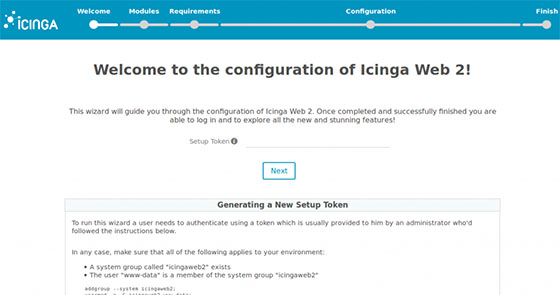
In this tutorial, we will show you how to install and configuration of Icinga 2 on your Ubuntu 16.04 server. For those of you who didn’t know, Icinga 2 is an open-source network monitoring system that checks the availability of your network resources, notifies users of outages, and generates performance data for reporting. It’s Scalable and extensible, Icinga2 can monitor large, complex environments across multiple locations.
This article assumes you have at least basic knowledge of Linux, know how to use the shell, and most importantly, you host your site on your own VPS. The installation is quite simple and assumes you are running in the root account, if not you may need to add ‘sudo‘ to the commands to get root privileges. I will show you the step-by-step installation of Icinga network monitoring on a Ubuntu 16.04 (Xenial Xerus) server.
Prerequisites
- A server running one of the following operating systems: Ubuntu 16.04 (Xenial Xerus).
- It’s recommended that you use a fresh OS install to prevent any potential issues.
- SSH access to the server (or just open Terminal if you’re on a desktop).
- A
non-root sudo useror access to theroot user. We recommend acting as anon-root sudo user, however, as you can harm your system if you’re not careful when acting as the root.
Icinga 2 Features
- Monitoring of network services (SMTP, POP3, HTTP, NNTP, ping, etc.)
- Monitoring of host resources (CPU load, disk usage, etc.)
- Monitoring of server components (switches, routers, temperature and humidity sensors, etc.)
- Simple plug-in design that allows users to easily develop their own service checks,
- Parallelized service checks.
- Ability to define network host hierarchy using “parent” hosts, allowing detection of and the distinction between hosts that are down and those that are unreachable.
- Ability to define event handlers to be run during service or host events for proactive problem resolution.
- Notification of contact persons when service or host problems occur and get resolved (via email, pager, or user-defined method).
- Escalation of alerts to other users or communication channels.
- Two optional user interfaces (Icinga Classic UI and Icinga Web) for visualization of host and service status, network maps, reports, logs, etc.
- Icinga Reporting module based on open source Jasper Reports for both Icinga Classic and Icinga Web user interfaces
- Capacity utilization reporting.
- Performance graphing via add-ons such as PNP4Nagios, NagiosGrapher, and InGraph.
Install Icinga 2 on Ubuntu 16.04
Step 1. First, make sure that all your system packages are up-to-date by running the following apt-get commands in the terminal.
sudo apt-get update sudo apt-get upgrade
Step 2. Install LAMP (Linux, Apache, MariaDB, PHP) server.
A Ubuntu 16.04 LAMP server is required. If you do not have LAMP installed, you can follow our guide here. Also, install all required PHP modules:
apt-get install php7.0-mysql php7.0-curl php7.0-json php7.0-cgi php7.0 libapache2-mod-php7.0 php7.0-mcrypt
Step 3. Installing Icinga 2.
First, enable the add-repository feature and add the repository for Icinga with the below commands:
apt install software-properties-common add-apt-repository ppa:formorer/icinga
Install Icinga 2 package:
apt update apt install icinga2
Once the installation is complete. Make sure the service is up and running fine:
systemctl status icinga2.service systemctl enable icinga2.service systemctl start icinga2.service
By default, Icinga2 enables the following features. But we can confirm the enabled settings by running this command as below:
icinga2 feature list
Step 3. Installing the Icinga2 plugin.
Icinga2 will collect the service information based on the monitoring plugins. So, we need to install the Nagios plugin using the below command:
apt install nagios-plugins
Next, you need to install the IDO module which is crucial for the Icinga 2 web interface. It will export all configuration and status information into its database. Execute the following command:
apt install icinga2-ido-mysql
Then restart Icinga 2 for the changes to take effect:
systemctl restart icinga2.service
Once you enabled the IDO modules, Icinga 2 places the new configuration file at /etc/icinga2/features-enabled/ido-mysql.conf in which we need to update the database credentials manually:
cat /etc/icinga2/features-enabled/ido-mysql.conf
Update the above file shown below:
root@idroot.us:~# nano /etc/icinga2/features-enabled/ido-mysql.conf
/**
* The db_ido_mysql library implements IDO functionality
* for MySQL.
*/
library "db_ido_mysql"
object IdoMysqlConnection "ido-mysql" {
user = "icinga2",
password = "icinga123",
host = "localhost",
database = "icinga2"
}
Step 4. Configuring MariaDB for Icinga 2.
By default, MariaDB is not hardened. You can secure MariaDB using the mysql_secure_installation script. You should read and below each step carefully which will set a root password, remove anonymous users, disallow remote root login, and remove the test database and access to secure MariaDB.
mysql_secure_installation
Configure it like this:
- Set root password? [Y/n] y - Remove anonymous users? [Y/n] y - Disallow root login remotely? [Y/n] y - Remove test database and access to it? [Y/n] y - Reload privilege tables now? [Y/n] y
Next, we will need to log in to the MariaDB console and create a database for Icinga 2. Run the following command:
mysql -u root -p
This will prompt you for a password, so enter your MariaDB root password and hit Enter. Once you are logged in to your database server you need to create a database for Icinga 2 installation:
MariaDB [(none)]> create database icinga2; MariaDB [(none)]> grant all privileges on icingaweb.* to icinga2@localhost identified by 'icinga123'; MariaDB [(none)]> flush privileges; MariaDB [(none)]> \q
Step 5. Installing Icinga 2 Web.
After creating the database, we can install the Web interface plugin and configure it one by one:
apt-get install icingaweb2
Step 6. Accessing Icinga 2.
Icinga2 will be available on HTTP port 80 by default. Open your favorite browser and navigate to http://yourdomain.com/icingaweb2/setup or http://server-ip/icingaweb2/setup and complete the required steps to finish the installation. If you are using a firewall, please open port 80 to enable access to the control panel.

Congratulations! You have successfully installed Icinga 2. Thanks for using this tutorial for installing Icinga 2 network monitoring on Ubuntu 16.04 LTS systems. For additional help or useful information, we recommend you to check the official Icinga 2 website.